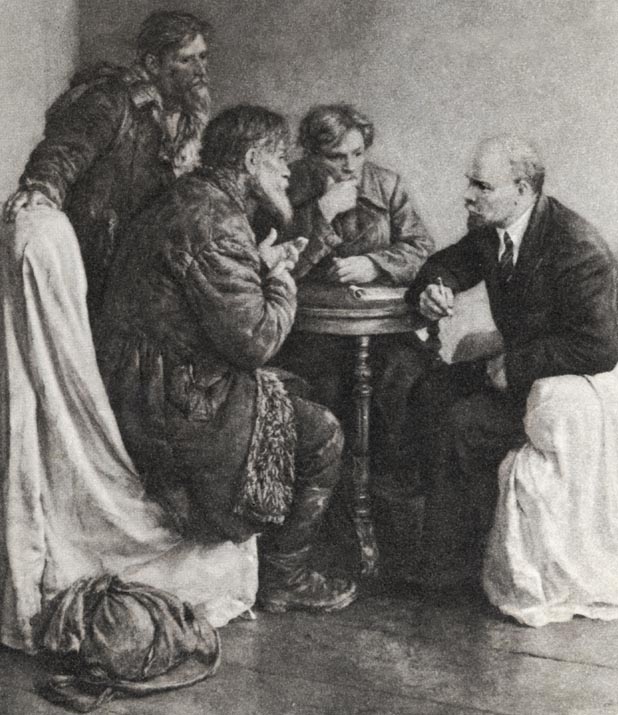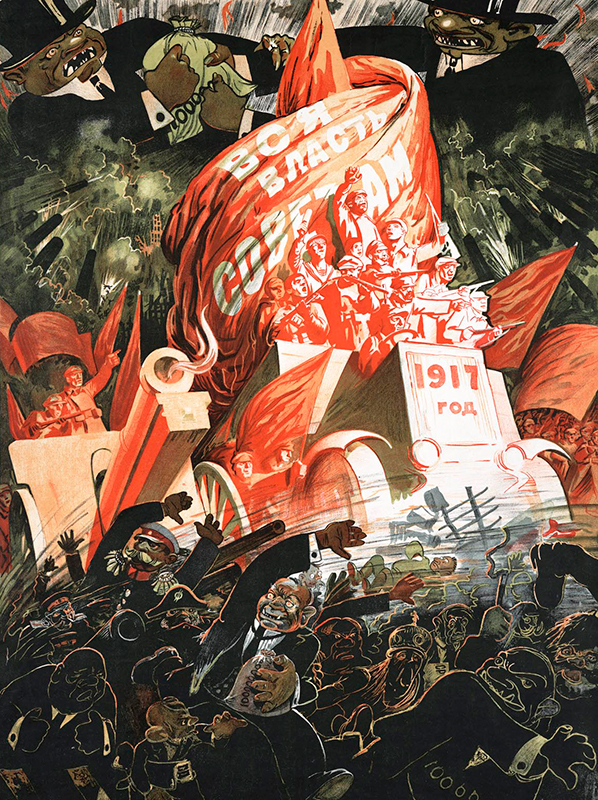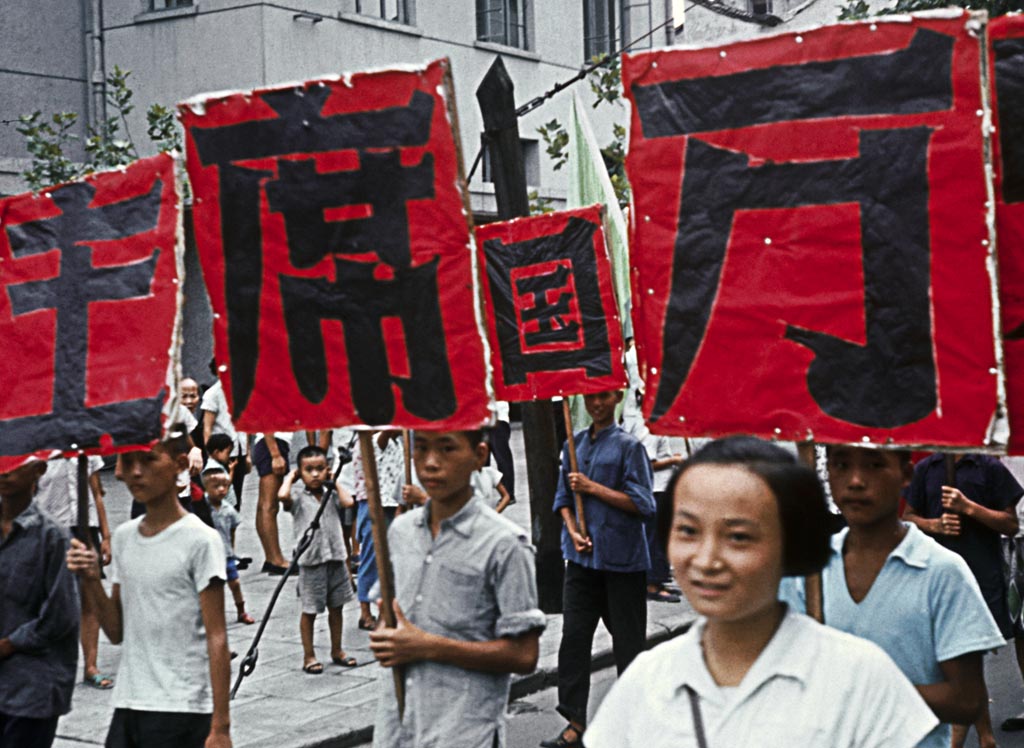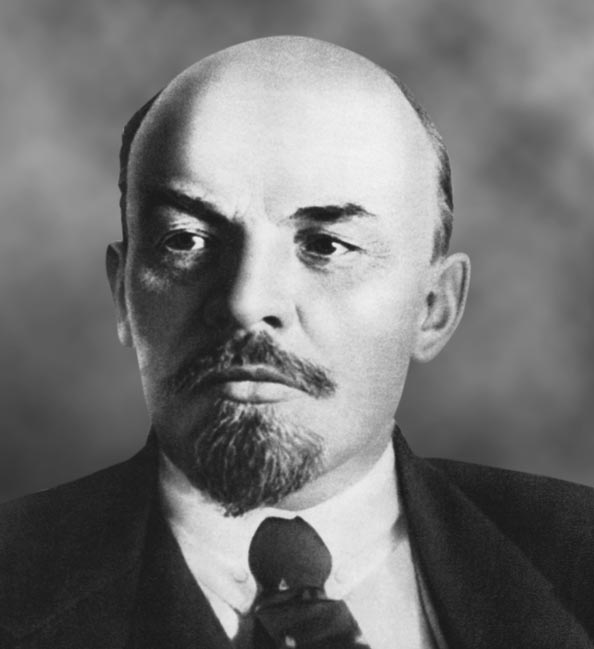
IN CONTEXT
Communism
Mass revolution
1793 During the Reign of Terror following the French Revolution, thousands are executed as “enemies of the revolution.”
1830s French political activist Auguste Blanqui teaches that a small band of expert conspirators can execute a revolutionary seizure of power.
1848 Karl Marx and Friedrich Engels publish the Communist Manifesto.
1921 The Communist Party of China (CPC) is organized as a Leninist vanguard party.
1927 Stalin reverses Lenin’s New Economic Policy and collectivizes agriculture.
At the turn of the 20th century, the Russian empire was a lumbering agrarian colossus that had fallen far behind the industrializing states of western Europe in economic terms. The empire’s population comprised many different ethnic groups—including Russians, Ukrainians, Poles, Belorussians, Jews, Finns, and Germans—only 40 percent of whom spoke Russian. The empire was ruled over by an absolutist, authoritarian tsar, Nicolas II, and a strict social hierarchy was ruthlessly enforced. There was no free press, no freedom of speech or association, no minority rights, and few political rights. Unsurprisingly, in this atmosphere of repression, revolutionary forces were gaining an ever-stronger foothold, and they would finally be carried to victory in the 1917 October Revolution by a political agitator named Vladimir Lenin.

A law of history
During the 19th century, socialism had developed in Europe as a response to the hardship that characterized the lives of the new industrial working class. Unprotected by social institutions or traditions such as unions, workers were particularly at risk of exploitation by their new employers. In response to their suffering, and believing that class conflict holds within it the dynamics of social change, Karl Marx and Friedrich Engels proclaimed that an international revolution against capitalism was inevitable. In the Communist Manifesto of 1848, they called for an international merger of the proletariat across Europe.
"We have combined, by a freely adopted decision, for the purpose of fighting the enemy."
Vladimir Lenin
However, Marx and Engels had not foreseen that as workers in the advanced industrialized societies of western Europe became more secure and began to acquire better living standards, they would aspire to become the bourgeoisie (middle class), not revolt against it. Socialists began more and more to work through legal and constitutional channels with the aim of winning the vote for working-class men and thereby achieving change through the democratic process. Socialist opinion became increasingly divided between those who advocated reform through the ballot box and those who sought reform through revolution.
Russian conditions
Russia had come late to industrialization and at the end of the 19th century, its working class had still not won any real concessions from their employers. Unlike the citizens of western Europe, the vast majority of Russia’s population had not seen any material benefits from industrialization. In the 1890s, growing numbers of political activists in Russia, including radical young law student Vladimir Lenin, plotted against the increasingly repressive state and its secret police force, and in 1905 a wave of unrest swept the country. This first attempt at a revolution failed to overthrow the tsar, but it did win some concessions to democracy. Russian workers continued to endure harsh conditions, however, and revolutionaries continued to plot the total overthrow of the tsarist regime.
Throughout his career, Lenin strove to translate Marxist theory into practical politics. Analyzing Russia’s position through a Marxist lens, he saw that the country was moving in sudden leaps from feudalism to capitalism. Lenin viewed the peasant economy as another exploitative plank in the capitalist platform—judging that if it were pulled out, the whole capitalist economy would collapse. However, as the peasants aspired to own their own land, Lenin realized they would not be the class to bring about a socialist revolution, one of whose central aims was the eventual ending of private ownership. It was clear to Lenin that the driving force of the revolution would have to be the burgeoning industrial working class.

Lenin initially attempted to garner support for the revolution from Russian peasants. He concluded that peasants could not form the revolutionary class because they aspired to own land.
Vanguard party
In Marxist analysis, the bourgeoisie is the middle class—the social class that owns the means of production (such as the factories)—while the proletariat comprises those who have no choice but to live off the sale of their own labor. Within the bourgeoisie were educated individuals, such as Lenin himself, who viewed the exploitation of the proletariat by the bourgeoisie as unjust, and agitated for change. Such “revolutionary bourgeois” individuals had played a leading role in past revolutions, including the French Revolution of 1789. However, the rapid industrialization of Russia was being financed largely by foreign capital, and this meant that the Russian bourgeoisie was a relatively small class. To make matters trickier still, there were few revolutionaries within their number.
Lenin understood that a revolution required leadership and organization, and he championed Engels’ and Marx’s idea of a “vanguard party”—a group of “resolute individuals” of clear political understanding, mostly recruited from the working class, who would spearhead the revolution. They were to inspire the proletariat to become a “class-for-itself,” which would then overthrow bourgeois supremacy and establish a democratic “dictatorship of the proletariat.” Lenin drew together his vanguard party under the name of the Bolsheviks; this party would ultimately become the Communist Party of the Soviet Union.

Rich bankers flee as the workers advance under the slogan “Long Live the International Socialist Revolution!,” a quote from Lenin emphasizing cross-border class allegiances.
International revolution
Like Marx, Lenin believed that a united proletariat would rise in a great revolutionary wave that would transcend borders and national identities, ethnocentrism, and religion, effectively becoming a borderless, classless state in itself. It would be an international expansion of “democracy for the poor,” and would occur alongside a forced suppression of the exploiting and oppressing class, who would be excluded from the new democracy. Lenin saw this transitory phase as an essential part of the shift from democracy to communism—the ultimate revolutionary state envisioned by Marx, which would follow the dictatorship of the proletariat. In this ultimate communist state, class would be transcended and private property abolished.
Lenin declared that his political ideas could take hold “not where there are thousands, but where there are millions. That is where serious politics begin.” In order to confront the might and force of the heavily armed imperialist state, millions of disaffected workers, alienated by that state, were needed to participate. Only in their united millions, organized by professional revolutionaries, could they hope to destroy a well-armed and well-financed capitalist regime. Under the tsars, the working classes and peasants had seen their own interests as dependent upon the interests of the owners of production or the landowner, but Lenin the Marxist urged them to see their rights and welfare as dependent only upon their own social class. The masses had been welded together into a single political body by their suffering, and now this was reinforced by constant rhetoric from Lenin’s Bolshevik lieutenants. For Lenin, the power of the masses was the only effective revolutionary power.
"Victory will belong only to those who have faith in the people, those who are immersed in the life-giving spring of popular creativity."
Vladimir Lenin
When Lenin delivered his political report to the Extraordinary Seventh Congress of the Russian Communist Party on March 6, 1918, a year after the successful 1917 revolution, he provided them with a review of the revolution that was “a truly Marxist substantiation of all our decisions.” His Bolshevik party had seized power from the transitional government the preceding October in what was essentially a bloodless coup d’etat. They were the first successful communist revolutionaries in the world. Even though Russia was a poor country within the capitalist finance system, with a relatively weak proletariat, its bourgeois state was even weaker, and the masses of working-class urban workers had been mobilized to dispossess it, resulting in an “easy victory.” One major factor in the success of the revolution had been Russia’s role in World War I. By 1917, the war was causing the Russian people intolerable hardship. Even death squads could not stop troop mutinies and desertions, and the “imperialist” war was transformed into civil war between the Bolshevik Red Army and the anti-Bolshevik White Army. Lenin wrote, “In this civil war, the overwhelming majority of the population proved to be on our side, and that is why victory was achieved with such extraordinary ease.” Everywhere he saw the fulfillment of Marx’s expectation that, as the proletariat learned through harsh experience that there could be no collaboration with the bourgeois state, the “fruit” of mass revolution would “ripen” spontaneously.
In reality, many other factors played a part. As the events of 1917 had played out, the institutions of the old order—the local administration, the army, and the Church—lost their authority. Both urban and rural economies collapsed. Russia’s forced withdrawal from World War I, and the subsequent civil war, took place against a backdrop of severe shortages, which brought about widespread suffering. Lenin had realized that only a dominant and coercive force could hope to create a new order out of this chaos. The Bolshevik party was the vanguard, but not the main substance of revolutionary power. Thinking in terms of the Marxian categories of the masses and blocks of workers and peasants, Lenin saw the proletarian democracy of the workers’ soviets (councils or groups) as the elementary substance of the new “commune” state. These groups united into one under the cry: “All Power to the Soviets!” In October 1917, the world’s first socialist state, the Russian Socialist Federative Soviet Republic, was born.

A rebellious army, sick of the appalling casualties of World War I, played a crucial role in making the 1917 October Revolution a success. The old regime was discredited by the war.
War Communism
Economically, the revolution was followed by three years of War Communism, which saw millions of Russian peasants die of starvation as food produced in the countryside was confiscated and brought to feed Bolshevik armies and cities, and to aid in the civil war against the anti-Bolshevik Whites. Conditions were so harsh that Lenin and the Bolsheviks faced uprisings from the same masses on whose support Lenin had based his politics. Historian David Christian writes that War Communism challenged the ideals of Lenin’s new Communist party, as “the government claiming to represent the working class now found itself on the verge of being overthrown by that same working class.”
"This struggle must be organized… by people who are professionally engaged in revolutionary activity."
Vladimir Lenin
While War Communism was the improvised condition that resulted from a revolution, what replaced it at the end of the civil war was a specific policy proposed by Lenin. The New Economic Policy, which Lenin referred to as state capitalism, allowed some small businesses, such as farms, to sell on their surpluses for personal gain. Large industries and banks remained in the hands of the state. The new policy, which was reviled by many Bolsheviks for diluting socialist economics with capitalist elements, succeeded in increasing agricultural production, since farmers were encouraged to produce larger quantities of food through appeal to their own self-interest. The policy was later replaced by Stalin’s policy of forced collectivism in the years after Lenin’s death, leading to more widespread famines in the 1930s.

During the civil war that followed the revolution, the Bolsheviks fought the anti-revolutionary “White Army.” Emergency measures were imposed, testing the support of the masses.
Proletarian power
The extent to which Lenin’s October Revolution was an authentically socialist revolution depends upon the extent to which “the masses” were actually in accord with and represented by the Bolsheviks. Was the suffering proletariat actually self-liberated “from below,” or did Bolshevik leaders ride to power on the Marxist narrative of victory for the suffering masses? How real was this new proletarian power—the power of the masses—which was brought into being and then constantly defined, explained, and eulogized by Lenin?
"Lenin alone could have led Russia into the enchanted quagmire; he alone could have found the way back to the causeway."
Winston Churchill
A contemporary of Lenin, Nikolay Sukhanov, a socialist activist and critic of the Bolshevik revolution, was skeptical. Sukhanov wrote: “Lenin is an orator of a great power who is capable of simplifying a complicated matter…the one who is pounding, pounding, and pounding people’s minds until they lose their will, until he enslaves them.”

In China’s Cultural Revolution, young Red Guards formed a vanguard, rooting out anti-revolutionary attitudes. Lenin believed that vanguards were needed to lead a revolution.
Labor aristocracy
Many critics have considered that when the Bolsheviks insisted that the dictatorship of the party was synonymous with a true workers’ state, they were in reality justifying their dominance over the workers. Lenin excused this dominance through his elitist belief that without the “professional revolutionaries,” workers on their own could not rise higher than a “trade union consciousness.” By this, he meant that workers would not see beyond alliances with their immediate colleagues at work to a wider class alliance.
Compounding the problem, in Lenin’s eyes, was the fact that the concessions won by the working classes in parts of western Europe had not lifted the working class as a whole. Rather, these concessions had created what Lenin called a “labor aristocracy”—a group of workers who had won significant concessions and as a result had become detached from their true class allegiance. For Lenin, the situation required a “revolutionary socialist consciousness” that could grasp Marxist principles of class unification. This could only be provided by a vanguard from within the working class—and the Bolsheviks formed that vanguard party.
Lenin held that the existence of absolute truth was unconditional, and further that Marxism was truth, which left no room for dissent. This absolutism gave Bolshevism an authoritarian, anti-democratic, and elitist nature that would seem to be at odds with a belief in bottom-up democracy. His vanguard-party revolution has since been replicated across the political spectrum, from the right-wing anti-communist Kuomintang Party in Taiwan to the Communist Party of China. Some intellectuals still describe themselves as “Leninists,” including Slovenian philosopher Slavoj Zizek, who admires Lenin’s desire to apply Marxist theory in practice and his willingness “to dirty his hands” in order to achieve his aims. Contemporary Leninists see globalization as the continuation of the 19th-century imperialism that Lenin opposed, as capitalist interests turn toward poor countries in search of new labor forces to exploit. Their solution to this problem, like Lenin’s a century ago, is an international mass workers’ movement.
VLADIMIR LENIN

Vladimir Ilich Ulyanov, who later adopted the surname Lenin, was born in Simbirsk, Russia, now called Ulyanovsk. He received a classical education and showed a gift for Latin and Greek. In 1887, his brother Aleksandr was executed for the attempted assassination of Tsar Alexander III. That year, Lenin enrolled at Kazan University to study law but was expelled for student protests. Exiled to his grandfather’s estate, he steeped himself in the works of Karl Marx. He received his law degree and began his real career as a professional revolutionary. He was arrested, jailed, exiled to Siberia, and then traveled through Europe, writing and organizing for the coming revolution. The October Revolution of 1917 effectively made him ruler of all Russia. Lenin survived an assassination attempt in 1918, but never fully regained his health.
Key works
1902 What Is To Be Done?
1917 Imperialism, the Highest Stage of Capitalism
1917 The State and Revolution
See also: Karl Marx • Joseph Stalin • Leon Trotsky • Mao Zedong
